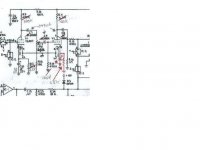I'm working on the tube (12AX7) overdrive section of the preamp of a Music Man guitar amp. I'm playing with and basically have the sound I want with the hand written changes on the attached schematic. (The entire schematice can be viewed at: http://www.ernieball.com/mmonline/techinfo/old_amps/1650-rd.pdf) However, when I play low notes, I loose definition and the sound is kind of farty. Not real bad, just bad enough. I want to keep the full tone, without the farts. I've played with different coupling cap values, but then I tend to loose the full tone. I've also played with the cathode paypass caps, not a huge difference, looses a bit of drive as I reduce the value of C10. Any suggestions welcome. Thanks.
Attachments
Basically, you've dropped the rolloff frequency by increasing the coupling caps, so you'll need to decouple the stages better. Think about using 10u or so at the top of each plate resistor. Now, this might change the tone because of slower sag under load, so listen up for that.
Try replacing C6 with something a little larger than 0.047uF, that may help.. Say 4.7uF 
The question is what other changes further up the signal chain need to be made. The farting noise you refer to could be a variety of things including saturation of the output transformer. It probably wasn't designed to handle much in the way of low frequencies.
Kevin
The question is what other changes further up the signal chain need to be made. The farting noise you refer to could be a variety of things including saturation of the output transformer. It probably wasn't designed to handle much in the way of low frequencies.
Kevin
Here's what I've done since my post. I did some math and discovered that when I changed the coupling caps to .047uf, I reduced the rollof to about 7Hz. So, I put the coupling caps back to the original value of .01uf, which results in a roll off of about 33Hz. Also, I changed C35 from 2uf to 4uf. Still have good tone, but still have the farts, but maybe a bit less.
What's the purpose of C6? I notice on later versions of this amp, the same value was used, but at 400v rather than 250v as on mine. What should the effect be of changing this from .047uf to .47uf? I thought this affected the high frequencies in the circuit?
Thanks
What's the purpose of C6? I notice on later versions of this amp, the same value was used, but at 400v rather than 250v as on mine. What should the effect be of changing this from .047uf to .47uf? I thought this affected the high frequencies in the circuit?
Thanks
From my side, I see that the original C6 would have given a -3 dB point at about 30 Hz, so one wonders if that had anything to do with a certain bass effect. All the time constants in the shown circuit could certainly have caused some audible effect (desired by the original designer?) I see no feedback, so there would not have been a peek, though feedback is possibly occuring through the ht line. One just wonders whatever could the purpose have been with such a low C6 - hardly decoupling!
I was unable to download the full circuit for some strange reason, so am not able to check what kind of total gain is available. I would thus also support the suggestion of increasing C6 to a few uF to start with. After that it begins to be difficult to come up with a diagnosis without seeing the exact nature of the disturbance.
I was unable to download the full circuit for some strange reason, so am not able to check what kind of total gain is available. I would thus also support the suggestion of increasing C6 to a few uF to start with. After that it begins to be difficult to come up with a diagnosis without seeing the exact nature of the disturbance.
I was wondering whether or not you are using an ernie ball musicman/stingray bass and whether or not it has fishman piezo undersaddle pickups? Some of the electronics in these things produce substantial subsonic cr*p which could be at the root of your problem. A small coupling capacitor right at the input of the amplifier might help.
Kevin
Kevin
No bass guitar, this is a regular guitar amp. The amp has two channels and this circuit is the overdrive preamp channel for leads and such. So lows are not critical other than shaping the overall tone, but of course that's what it's all about -- good tone. After thinking about it, I think I will try increasing the value of C6 as suggested, but I will also increase the plate and cathode resistor values. By doing this, the 12AX7 should work more efficiently, reducing the amount of power the circuit uses to get that cool overdrive sound. Hopefully keeping the power reserve for tight bass sound.
Any other thoughts are welcome!
Any other thoughts are welcome!
Also, Channel 1, the clean channel, I'm very happy with. In fact, this channel that I'm tinkering with, channel 2, sounds very good when I run it clean, no overdrive. So, I'm leaning toward the idea that I'm starving the preamp of power, channel 2. I notice in later versions of this amp, Music Man used higher value resistors for the plate and cathode, which would make the tube work more efficiently. I think they used something like 450k plate and 4.5K cathode, or something like that. Any opinions on this idea?
- Status
- This old topic is closed. If you want to reopen this topic, contact a moderator using the "Report Post" button.
- Home
- Amplifiers
- Tubes / Valves
- Help me stop my preamp from farting!
